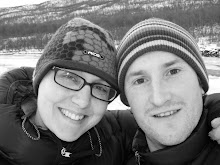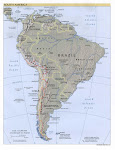So we will explain our most painful but beautiful stage in detail, make yourselves comfortable...
DAY 1: San Pedro - Laguna Verde
It took us two days, two days!, to find somebody to give us a lift up the mountain side. From San Pedro to the border with Bolivia the road rises over 2,000m in just 45kms. No way were we cyling that, not after the climb of Lipan in the previous stage.
At the border we waved goodbye to Chile for the last time, cycled down to Laguna Blanca and battled through some ripio for a couple of hours to Laguna Verde. After crossing (cycling through) the stream between the two lakes we sat down for lunch. Laguna Verde was grey when we arrived but while we sat there it turned a bright green in just a few minutes. Very bizarre and very spectacular.
DAY 2: Laguna Verde - Laguna Chalviri
We woke in the morning absolutely freezing. Morning temperature of -10C was not nice to get ready in. Most of our water had frozen overnight leaving us with just enough to make breakfast and hope that some would melt before we got thirsty.
We woke in the morning absolutely freezing. Morning temperature of -10C was not nice to get ready in. Most of our water had frozen overnight leaving us with just enough to make breakfast and hope that some would melt before we got thirsty.



The route from here was not too bad. A little sandy in places, we had to push the bikes occasionally before we reached our first pass. At 4,700m we were left panting like excited puppies. The other side was not much better. Even going downhill was slow as our wheels buried into the sand. The Dali desert was just as you'd expect from the name. For us, the 'desert' bit was most descriptive.
At Laguna Chalviri we found oursleves alone with a family of Bolivians who run the refuge there. We enjoyed the hot springs, Ian needed the bath desperately. We slept that night on the floor of the restaurant, a bit warmer than the tent.
DAY 3: Laguna Chalviri - Laguna Colorada
We were rudely awaken by the early arrival of jeep tours. Hoards of tourists expecting hot drinks and breakfast came pouring in just as we were wiping the sleep from our eyes and having a good morning scrat.

Before they got chance to pester us with ridiculous questions we headed north for Laguna Colorada. The route was slightly better, we managed to cycle most of the way. The pass on this day took us to our highest point so far, and probably of the entire trip. At 4,950m we were suffering with headaches and struggling to breath. We assumed it must have been the altitude, but maybe it was also something to do with our little side trip to the bubbling hot pools of sulphuric acid.



Coming down from this height was a great relief and a lot of fun. We found ourselves a nice campsite in a dry river canyon not far from Laguna Colorada.
Day 4: Laguna Colorada - Laguna Capina
We woke up in the morning with -15C. God only knows how cold it was in the night but it can get between -20 and -30C! We raced down to the lake side though, Laguna Colorada is well known for its flamingoes. Because we arrived early and it was still freezing, the edge of the lake was covered in ice. Obviously that meant Ian would wander out on the ice hoping to get a bit closer to the stinking birds.
They were magnificent and beautiful to watch for a while.



This day we had to endure another 4,700m pass, but fortunately again the route was not too bad. We arrived at the next lake to find a dual carriageway Bolivian style!
Passing a couple of mines and nearby settlements, we found ourselves another cold campsite. This time another abandoned building to shelter from the wind. Unfortunately the building was so small our tent would not fit inside, we had to only put it half up.
DAY 5: Laguna Capina - Villa Mar
Following the lakes, we didn't really have much interest in the next part until the great Salar de Uyuni. So this day was rather uneventful. We cycled over another mountain pass and the route seemed to worsen a bit.
Much steeper, much more rocky and great danger of being spat at by local wildlife.



We eventually arrived at our first Bolivian town after pushing the bikes through some pretty deep sand. We found ourselves a hostel with real beds and found some nice lady to cook us some soup and some pasta. It felt like a great treat until we tried the shower. Hot water was supposedly available. Maybe out here, when water is in liquid form and not solid, it is deemed hot no matter what temperature it is.
DAY 6: Villa Mar - Villa Alota
Our first reasonably flat day in Bolivia was quite nice. We first had to cross the river which was not quite fully frozen.
The route was then pretty rideable for the most part, the sand wasn't too deep. We were told in Villa Mar that the distance was only 30kms so we were looking forward to a quick easy day. We soon learned that Bolivians are quite terrible with distances.
After 50kms we eventually arrived in town and found ourselves a hostel with hot water that actually steamed.
DAY 7: Villa Alota - San Agustin
Without doubt, our worst day of the whole trip so far. Asking for directions in Alota was like asking Stevie Wonder to point north. We did the best we could with our Chilean maps but still found ourselves heading the wrong direction early on. After turning back and riding 10 pointless kms, we found our route north. The route wasn't easy with lots of deep sand and many rocks. Gemma's front tyre disapproved of our route and without notice, just erupted.


On with the spare tyre we continued cycling and pushing through ever deepening sand. During a short break a local guy appeared out of nowhere and chatted to us. No idea what he said but it sounded interesting. We did mange to decipher a few important sentences despite his lack of teeth, mainly that we were on the road to San Agustin (not to Chiguana as we originally intended) and that it was still 30kms over the hill.
A big, unexpected hill. Another 4,700m mountain pass to be precise. And this one was horrendously rocky, very steep and mostly unrideable. We pushed and puffed our way to the top hoping for some nice downhill into the next town. Unfortunately the road just worsened and the ride down was just as slow as going up.
The last few kms into San Agustin were through deep sand again. We arrived as day light was fading but just in time to find a local boy to show us the way to somewhere to sleep (there were no signs in this town). The boy showed us to a random door in a dusty alleyway and then he legged it.
We were a bit suspicious but desperate for a bed, so knocked anyway. The man who answered laughed as we asked for a room, this was not a hostel. Fortunately though, he had a garage with a couple of bunk beds in, we could sleep there. With his chickens. Luckily there were no pigs.
We slept very well.
DAY 8: San Agustin - Kolcha 'K'
And woke up cold.
The man came in to show us a map of the area, he drew it in the dusty floor with his pokey finger, telling us it would be only 45kms to Kolcha K with a slight hill along the way.
Our maps did not show any hills from here on but there it was, another nasty pass to tackle.
Expecting to arrive at Julaca about half way, we were disappointed to find it was much further than we were told. This rusty old railway town was deserted and we soon moved through to continue north.
From here the route flattened out and we quickened a little. Still, a long afternoon and nearly 20kms more than the 45 we were told, we arrived in Kolcha K and found ourselves a nice shop with loads of chocolate and fizzy drinks.
Day 9: Kolcha ´K´ - Isla Incahuasi (Salar de Uyuni)
Knowing that today we would get onto the salar, we rushed quickly through the last 20kms of sand. Not long after we were cycling on the biggest salt flat in the world. It was flat, firm and there lots of jeep tracks to guide us to the island in the middle of the vast sea. Much easier riding than anything from the previous days on this stage.
Reaching the island we shouldn´t have been, but were still amazed by the amount of jeeps full of other tourists were there. We headed straight for the restaurant and ordered big llama burgers - a wonderful change from our monotonous diet of rice or pasta with tinned fish.
Once all the tours had left the island we had a wander around, the island boasts stunning views wherever you go. We then asked to stay overnight in the refugio, definitely an experience we´ll never forget. A huge room with big windows overlooking the salar. The sunset, the night-sky and the sunrise were absolutely astounding.
Day 10: Isla Incahuasi - Uyuni
A big day. After signing the cyclists guestbook we headed out across the salt flats, took loads of photos and pushed on while the going was still flat and firm.
Near the eastern edge of the salar is a ´Salt Hotel´ obviously built from the salt. Much like the ice hotel in Sweden, it wasn´t as great as the hype, but they did have Snickers bars which made us very happy.
Back off the salar it was a further 25kms to Uyuni and a well deserved rest. The road was again very sandy and unbelievably bumpy. A sure sign of things to come as we head through Bolivia.
Knackered, filthy, hungry and in pain, we arrived in town after dusk following a 100km day.
While on this stage we had many encounters with the jeep tours. Here are some of our favourite questions posed to us: -
- Are you guys cycling?
- How do you go to the toilet?
- Where have you cycled from? (Ushuaia) Wow, you must have arrived late!
- Where did you cycle from? (San Pedro) What, in one day?!
- How do you know where you´re going?
Unfortunately most of these idiots were English. What a shame.
Anyhoo... after our rest in Uyuni we head to Potosi and Sucre. With saddle sores and ripio rashes we will be busing it to Potosi as the road is rumoured to be in very bad condition.
Until next time,
love you all,
Ian and Gemma
xxx
















































